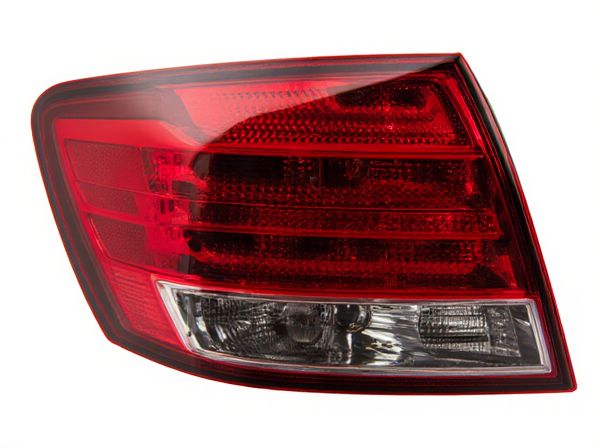
Photo illustration: Matrix Taillight vs Conventional Taillight
Matrix taillights offer advanced light distribution technology that enhances visibility and safety by precisely controlling individual LEDs, unlike conventional taillights which emit a uniform beam. Your driving experience improves with dynamic signaling and adaptive brightness, ensuring clearer communication with other drivers. This innovative lighting system also increases energy efficiency and longevity compared to traditional setups.
Table of Comparison
| Feature | Matrix Taillight | Conventional Taillight |
|---|---|---|
| Light Technology | LED Matrix with individual segments | Standard LED or Halogen bulbs |
| Brightness | Adaptive brightness for optimal visibility | Fixed brightness level |
| Functionality | Dynamic light patterns and signaling | Static illumination and basic signals |
| Energy Efficiency | High efficiency, lower power consumption | Moderate efficiency, higher consumption |
| Safety | Enhanced safety with targeted light distribution | Standard safety with uniform light output |
| Durability | Long lifespan, resistant to shocks | Shorter lifespan, more fragile components |
| Cost | Higher initial cost due to advanced tech | Lower cost, widely available |
Introduction to Automotive Taillights
Automotive taillights serve a crucial role in vehicle safety by enhancing visibility and signaling intentions to other drivers. Matrix taillights utilize advanced LED technology with dynamic, adaptive light patterns that improve illumination and communication efficiency compared to conventional taillights, which rely on static bulbs with limited signaling capabilities. The integration of sensors and microprocessors in matrix taillights allows for real-time adjustments to light intensity and distribution, optimizing safety and aesthetics on the road.
What is a Matrix Taillight?
A Matrix taillight is an advanced automotive lighting technology featuring multiple individually controlled LED segments that enhance visibility and communication with other drivers. Unlike conventional taillights that emit uniform illumination, Matrix taillights dynamically adjust brightness and light patterns to improve safety by signaling braking, turning, or hazard warnings more precisely. This intelligent lighting system contributes to better road awareness and adaptive signaling in various driving conditions.
Understanding Conventional Taillights
Conventional taillights use standard incandescent or LED bulbs that emit a uniform light pattern, providing consistent rear visibility for vehicles. These taillights often lack the dynamic lighting features found in advanced systems, limiting their ability to convey nuanced signals or enhance aesthetic appeal. Understanding their basic operation helps underscore the improvements matrix taillights offer in terms of adaptive illumination and safety.
Key Differences: Matrix vs Conventional Taillights
Matrix taillights use multiple individually controlled LEDs to create adaptive lighting patterns that enhance visibility and communication with other drivers, whereas conventional taillights rely on static bulbs or simple LED configurations. The advanced control system in matrix taillights allows dynamic brightness adjustment and selective illumination to prevent glare, improving safety in varying road conditions. Conventional taillights lack this flexibility, offering uniform brightness and limited signaling capabilities without adaptive features.
Technological Advancements in Matrix Taillights
Matrix taillights leverage advanced LED and microprocessor technology to selectively illuminate individual segments, enhancing visibility and safety by providing dynamic lighting patterns tailored to driving conditions. Unlike conventional taillights, which rely on uniform illumination, matrix taillights enable adaptive brightness control, precise signaling, and reduced glare for following vehicles. This technological advancement integrates sensors and real-time processing, delivering superior functionality and energy efficiency in modern automotive lighting systems.
Visibility and Safety Comparison
Matrix taillights enhance visibility by dynamically adjusting light patterns to prevent glare while maintaining optimal brightness, outperforming conventional taillights with fixed illumination. Their advanced LED technology offers faster response times and clearer signaling, significantly improving driver reaction and overall road safety. Enhanced visibility in adverse weather and varying traffic conditions makes matrix taillights a superior choice for accident prevention compared to traditional taillight systems.
Design and Aesthetic Features
Matrix taillights utilize advanced LED arrays to create dynamic, customizable lighting patterns that enhance vehicle aesthetics with sleek, futuristic designs. Conventional taillights often rely on static bulbs and simpler shapes, limiting their visual appeal and modernity. Matrix technology enables precise light modulation, offering improved visibility and a distinctive, high-tech appearance compared to traditional counterparts.
Energy Efficiency and Longevity
Matrix taillights utilize advanced LED technology with adaptive light distribution, resulting in significantly lower energy consumption compared to conventional halogen or incandescent taillights. Their superior heat dissipation and solid-state design contribute to a longer operational lifespan, often exceeding 30,000 hours, whereas traditional taillights generally last around 1,000 to 2,000 hours. This energy efficiency and durability make matrix taillights a preferred choice for modern automotive lighting systems.
Cost and Maintenance Factors
Matrix taillights generally have a higher upfront cost compared to conventional taillights due to advanced LED technology and integrated control systems. Maintenance expenses for matrix taillights can also be greater, as repairs often require specialized components and professional servicing, whereas conventional taillights feature simpler designs with readily available replacement parts. Over time, conventional taillights tend to incur lower total cost of ownership because their maintenance is more straightforward and less expensive.
Future Trends in Taillight Technology
Matrix taillights offer advanced adaptive lighting patterns using LED arrays controlled by microprocessors, enabling dynamic signaling and enhanced visibility compared to conventional taillights. Future trends point toward increased integration of smart connectivity, allowing taillights to communicate with other vehicles and infrastructure for improved safety and autonomous driving support. Emerging technologies include laser-based and OLED taillights, promising higher efficiency, design flexibility, and more precise light modulation.
 caratoz.com
caratoz.com